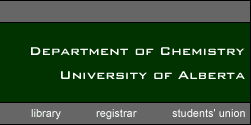


Chem 263 - Course Information
General Information
Course Objectives
Texts
Grades
Laboratory
Difficulties
Lecture Help Sessions
Problem Sets
Exam Answers
Ethical Considerations
Download pdf
General Information:
- Section: B6
- Classes: T R, 12:30 - 13:50
- First Day: January 10, 2006
- Room: Chemistry East E1-60
- Office: Chemistry West W5-09
- Office Hours: Tues & Thurs 14:00 to 15:00 (drop in at Chemistry W5-09) or by appointment
Course Objectives:
The goal of this course is to understand the structure, nomenclature, physical properties and reactions of common classes of organic compounds. Their natural occurrence, use and applications are also described. Special emphasis in this second course in organic chemistry will be on polyenes, aromatic compounds, aldehydes and ketones (including carbohydrates), carboxylic acids and derivatives and amines.
Texts:
- "Organic Chemistry", TWG Solomons and CB Fryhle, 8th Edition, John Wiley and Sons Inc., 2004 - Available U.A. Bookstore.
- "Organic Chemistry Experiments for Chemistry 161/263 and Chemistry 263", L.M. Browne, 2005-2006 Edition, University of Alberta - Available at U.A. Bookstore.
- "Chemistry 161/163 and Chemistry 263 Laboratory Report Book", L.M. Browne, 2005-2006 Edition, University of Alberta - Available at U.A. Bookstore.
- Molecular Models:
Molecular models will be essential in this course. Although several types are available, the Darling Molecular Models are recommended. These are available from Chemistry Undergraduate Stores (1st Floor, West Wing Chemistry).
- Recommended Text:
"Study Guide and Solutions Manual" for TWG Solomons and CB Fryhle, - Available U.A. Bookstore.
Grade Distribution & Tentative Exam Dates (subject to change):
- Midterm Exam (1) = 360 points
- Tuesday, February 28, 2006
- No books, notes or electronic devices
- Answers will be posted after exam
- Final Exam (no supplemental exam) = 390 points
- Wednesday, April 26, 2006
- Bring Student ID and Models - No books, notes or electronic devices
- Laboratory = 250 points
- You must pass the laboratory component with a grade of 60% or better to pass the course
- Lab Experiments & Quizzes - 175 points
- Lab Exam - 75
- TOTAL = 1000 points
Laboratory Component
- You must pass the laboratory part with a grade of 60% or better to pass the course.
- Labs begin on Monday, January 23, 2006
- Term Lab Assignments (locations) will be posted in the Chemistry East concourse, beside Chemistry East, Room E1-26 by Monday morning, January 23, 2006.
- Melting points outside of scheduled lab classes will be done in Room W1-39.
- Lab Help Sessions:V wing Room to be announced. Times: Monday – Friday 17:00
- Lab Preview Sessions:Room to be announced. Times: Monday – Thursday 11:00
Difficulties:
- Chemistry 261/263 registration and scheduling problems, laboratory problems (missed experiments, conflicts, etc.): see Dr. Lois Browne, Chemistry E1-34B.
Lecture Help Sessions:
- Room E1-34.
- Times:
- Monday 15:00 - 17:00
- Tuesday 11:00 - 13:00, Tues 15:00 - 17:00
- Wednesday 11:00 - 13:00
- Thursday 15:00 - 17:00
- Friday 9:00 - 11:00
Problem Sets:
- Problems will be assigned from text and will not be collected or graded.
- Answers are available from the Solutions Manual
Examination Answers:
- Answers to examinations (mid-terms) will be made available after the examination at this web site.
- Click on Exams in the menu at the top of this page.
Ethical Considerations:
- Students should read the University of Alberta regulations regarding violation of ethical standards (e.g. cheating) and penalties.
- General Policies are given in the:
- University Calendar ->-> Section 30 (particularly Section 30.3.2)
